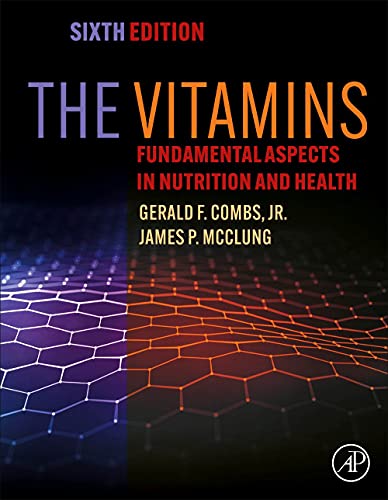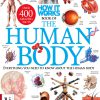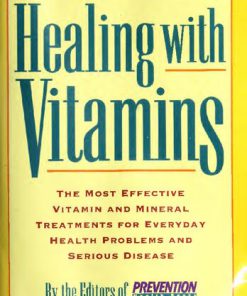The Vitamins Fundamental Aspects in Nutrition and Health 6th editon by Gerald Combs, James McClung ISBN 0323918263 9780323918268
$50.00 Original price was: $50.00.$25.00Current price is: $25.00.
The Vitamins Fundamental Aspects in Nutrition and Health 6th editon by Gerald Combs, James McClung – Ebook PDF Instant Download/Delivery: 0323918263, 9780323918268
Full dowload The Vitamins Fundamental Aspects in Nutrition and Health 6th editon after payment

Product details:
ISBN 10: 0323918263
ISBN 13: 9780323918268
Author: Gerald F. Combs Jr.; James P. McClung
The Vitamins: Fundamental Aspects in Nutrition and Health, Sixth Edition presents both overviews and in-depth discussions of the sources, chemistry, metabolism and functions of these essential nutrients in physiology and health. Sections cover perspectives (history of discovery, general properties and impacts), individual Vitamins (their respective chemistries, metabolism), and their dietary sources and global needs. In addition, the inclusion and interpretation of recent clinical research findings relevant to all vitamins, particularly vitamins A, D, E, K, C, thiamin, folate and vitamin B12 is included, along with an expanded discussion on single-carbon metabolism), implications to neuropathies, and more.
- Presents complete information about vitamins in a format useful as both a teaching text and desk reference
- Includes coverage of vitamin-related topics not typically found in general nutrition texts (e.g., enteric microbial biosynthesis of vitamins, global prevalence of deficiencies, diagnosing ‘silent’ asymptomatic vitamin deficiencies, histories of vitamin discoveries)
- Contains useful appendices of key reference information (e.g., vitamin requirements of humans and animals, vitamin contents of foods, sources of vitamin information)
The Vitamins Fundamental Aspects in Nutrition and Health 6th Table of contents:
Part I. Perspectives on the vitamins in nutrition
Chapter 1. What is a vitamin?
Anchoring concepts
Learning objectives
Vocabulary
1. Thinking about vitamins
2. Vitamin: a revolutionary concept
3. An operating definition
4. The recognized vitamins
5. Chapter quiz
Chapter 2. Discovery of the vitamins
Anchoring concepts
Learning objectives
Vocabulary
1. Emergence of nutrition as a science
2. Processes of discovery in nutritional science
3. The empirical phase of vitamin discovery
4. The experimental phase of vitamin discovery
5. The vitamine theory
6. Elucidation of the vitamins
7. Vitamin terminology
8. Other factors sometimes called vitamins
9. Modern history of the vitamins
10. Chapter quiz
Chapter 3. General properties of vitamins
Anchoring concepts
Learning objectives
Vocabulary
1. Vitamin nomenclature
2. Chemical and physical properties of the vitamins
3. Physiological utilization of the vitamins
4. Metabolism of the vitamins
5. Metabolic functions of the vitamins
6. Vitamin bioavailability
7. Vitamin analysis
8. Chapter quiz
Chapter 4. Vitamin deficiency
Anchoring concepts
Learning objectives
Vocabulary
1. The concept of vitamin deficiency
2. Clinical manifestations of vitamin deficiencies
3. Biochemical lesions of vitamin deficiencies
4. Diagnosing vitamin deficiencies
5. Contexts of vitamin deficiencies
6. Effective interventions
7. Chapter quiz
Part II. The individual vitamins
Chapter 5. Vitamin A
Anchoring concepts
Learning objectives
Vocabulary
1. Significance of vitamin A
2. Properties of vitamin A
3. Sources of vitamin A
4. Vitamin A absorption
5. Vitamin A transport
6. Vitamin A metabolism
7. Metabolic functions of vitamin A
8. Biomarkers of vitamin A status
9. Vitamin A requirements
10. Vitamin A deficiency
11. Other deficiency signs in humans
12. Other roles of vitamin A in health and disease
13. Vitamin A toxicity
14. Case studies
15. Chapter quiz
Chapter 6. Vitamin D
Anchoring concepts
Learning objectives
Vocabulary
1. Significance of vitamin D
2. Properties of vitamin D
3. Sources of vitamin D
4. Vitamin D absorption
5. Vitamin D transport
6. Vitamin D metabolism
7. Metabolic functions of vitamin D
8. Biomarkers of vitamin D status
9. Vitamin D requirements
10. Vitamin D deficiency
11. Other roles of vitamin D in health and disease
12. Vitamin D toxicity
13. Case studies
14. Chapter quiz
Chapter 7. Vitamin E
Anchoring concepts
Learning objectives
Vocabulary
1. Significance of vitamin E
2. Properties of vitamin E
3. Sources of vitamin E
4. Vitamin E absorption
5. Vitamin E
6. Vitamin E metabolism
7. Oxidative shortening of the phytyl side chain
8. Metabolic functions of vitamin E
9. Biomarkers of vitamin E status
10. Vitamin E requirements
11. Vitamin E deficiency
12. Vitamin E deficiency signs in humans
13. Vitamin E deficiency signs in animals
14. Other roles of vitamin E in health and disease
15. Vitamin E toxicity
16. Case studies
17. Chapter quiz
Chapter 8. Vitamin K
Anchoring concepts
Learning objectives
Vocabulary
1. Significance of vitamin K
2. Properties of vitamin K
3. Sources of vitamin K
4. Vitamin K absorption
5. Vitamin K
6. Vitamin K metabolism
7. Metabolic functions of vitamin K
8. Biomarkers of vitamin K status
9. Vitamin K requirements
10. Vitamin K deficiency
11. Other roles of vitamin K in health and disease
12. Vitamin K toxicity
13. Case studies
14. Chapter quiz
Chapter 9. Vitamin C
Anchoring concepts
Learning objectives
Vocabulary
1. Significance of vitamin C
2. Properties of vitamin C
3. Sources of vitamin C
4. Vitamin C
5. Vitamin C
6. Vitamin C
7. Metabolic functions of vitamin C
8. Biomarkers of vitamin C status
9. Vitamin C requirements
10. Vitamin C deficiency
11. Other roles of vitamin C in health and disease
12. Vitamin C toxicity
13. Case studies
14. Chapter quiz
Chapter 10. Thiamin
Anchoring concepts
Learning objectives
Vocabulary
1. Significance of thiamin
2. Properties of thiamin
3. Thiamin chemistry
4. Sources of thiamin
5. Thiamin absorption
6. Thiamin transport
7. Thiamin metabolism
8. Metabolic functions of thiamin
9. Biomarkers of thiamin status
10. Thiamin requirements
11. Thiamin deficiency
12. Signs in humans
13. Other roles of thiamin in health and disease
14. Thiamin toxicity
15. Case studies
16. Chapter quiz
Chapter 11. Riboflavin
Anchoring concepts
Learning objectives
Vocabulary
1. Significance of riboflavin
2. Properties of riboflavin
3. Sources of riboflavin
4. Riboflavin absorption
5. Riboflavin transport
6. Riboflavin metabolism
7. Metabolic functions of riboflavin
8. Biomarkers of riboflavin status
9. Riboflavin requirements
10. Riboflavin deficiency
11. Other roles of riboflavin in health and disease
12. Riboflavin toxicity
13. Case study
14. Chapter quiz
Chapter 12. Niacin
Anchoring concepts
Learning objectives
Vocabulary
1. Significance of niacin
2. Properties of niacin
3. Sources of niacin
4. Niacin absorption
5. Niacin transport
6. Niacin metabolism
7. Metabolic functions of niacin
8. Biomarkers of niacin status
9. Niacin requirements
10. Niacin deficiency
11. Other roles of niacin in health and disease
12. Niacin toxicity
13. Case studies
14. Chapter quiz
Chapter 13. Vitamin B6
Anchoring concepts
Learning objectives
Vocabulary
1. Significance of vitamin B6
2. Properties of vitamin B6
3. Sources of vitamin B6
4. Vitamin B6 absorption
5. Vitamin B6 transport
6. Vitamin B6 metabolism
7. Metabolic functions of vitamin B6
8. Biomarkers of vitamin B6 status
9. Vitamin B6 requirements
10. Vitamin B6 deficiency
11. Other roles of vitamin B6 in health and disease
12. Vitamin B6 toxicity
13. Case studies
14. Chapter quiz
Chapter 14. Biotin
Anchoring concepts
Learning objectives
Vocabulary
1. Significance of biotin
2. Properties of biotin
3. Sources of biotin
4. Biotin absorption
5. Biotin
6. Metabolic functions of biotin
7. Biomarkers of biotin status
8. Biotin requirements
9. Biotin deficiency
10. Other roles of biotin in health and disease
11. Biotin toxicity
12. Case studies
13. Chapter quiz
Chapter 15. Pantothenic acid
Anchoring concepts
Learning objectives
Vocabulary
1. Significance of pantothenic acid
2. Properties of pantothenic acid
3. Sources of pantothenic acid
4. Pantothenic acid absorption
5. Pantothenic acid transport
6. Pantothenic acid metabolism
7. Metabolic functions of pantothenic acid
8. Biomarkers of pantothenic acid status
9. Pantothenic acid requirements
10. Pantothenic acid deficiency
11. Other roles of pantothenic acid in health and disease
12. Pantothenic acid toxicity
13. Case studies
14. Chapter quiz
Chapter 16. Folate
Anchoring concepts
Learning objectives
Vocabulary
1. Significance of folate
2. Properties of folate
3. Sources of folate
4. Folate absorption
5. Folate transport
6. Folate metabolism
7. Metabolic functions of folate
8. Biomarkers of folate status
9. Folate requirements
10. Folate deficiency
11. Other roles of folate in health and disease
12. Folate toxicity
13. Case studies
14. Chapter quiz
Chapter 17. Vitamin B12
Anchoring concepts
Learning objectives
Vocabulary
1. Significance of vitamin B12
2. Properties of vitamin B12
3. Sources of vitamin B12
4. Vitamin B12 absorption
5. Vitamin B12 transport
6. Vitamin B12 metabolism
7. Metabolic functions of vitamin B12
8. Biomarkers of vitamin B12 status
9. Vitamin B12 requirements
10. Vitamin B12 deficiency
11. Other roles of vitamin B12 in health and disease
12. Vitamin B12 toxicity
13. Case studies
14. Chapter quiz
Chapter 18. Quasi-vitamins
Anchoring concepts
Learning objectives
Vocabulary
1. Is the list of vitamins complete?
Conditionally essential nutrients
3. Carnitine
4. myo-Inositol
5. Ubiquinones
6. Lipoic acid
Beneficial bioactive factors
8. Flavonoids
9. Unidentified factors
10. Case studies
11. Chapter quiz
Part III. Using current knowledge of the vitamins
Chapter 19. Sources of the vitamins
Anchoring concepts
Learning objectives
Vocabulary
1. Vitamins in foods and feedstuffs
2. Vitamin bioavailability
3. Vitamin losses in foods
4. Adding vitamins to foods
5. Biofortification
6. Vitamin labeling of foods
7. Vitamins in human diets
8. Vitamin supplementation
9. Vitamins in livestock feeding
10. Case study
11. Chapter quiz
Chapter 20. Assessing vitamin status
Anchoring concepts
Learning objectives
Vocabulary
1. Nutritional assessment
2. Biomarkers of vitamin status
3. Vitamin status of human populations
4. Global undernutrition
5. Chapter quiz
Chapter 21. Vitamin needs
Anchoring concepts
Learning objectives
Vocabulary
1. Dietary standards for vitamins
2. Vitamin allowances for humans
3. Vitamin allowances for animals
4. Case study
5. Chapter quiz
Chapter 22. Vitamin safety
Anchoring concepts
Learning objectives
Vocabulary
1. Uses of vitamins above required levels
2. Safe intakes of vitamins
3. Hypervitaminoses
4. Case studies
5. Chapter quiz
Appendix A
Appendix B. Original reports used for case studies
Appendix C. A core of current vitamin literature
Appendix D. Vitamin contents of foods (units per 100 g edible portion)
Appendix E. Vitamin contents of feedstuffs (units per kg)
Appendix F. 20 Questions to examine vitamin knowledge
Index
People also search for The Vitamins Fundamental Aspects in Nutrition and Health 6th:
what are the 9 nutritional components of a healthy diet
why should we include vitamins in our diet class 6th
what are the nutritional needs of your body
why is nutrition and health important
Tags:
Gerald Combs,James McClung,The Vitamins,Fundamental Aspects
You may also like…
Uncategorized
Medicine - Therapy
Nutrition for Health and Health Care 8th Edition Linda Kelly Debruyne
Uncategorized
Nutrition in Public Health 4th Edition by Sari Edelstein ISBN 9781284104691 1284104699
Uncategorized
Conservation of Renewable Natural Resources: Some Fundamental Aspects of the Problem Raphael Zon
Business & Economics
Economic Biology and Behavioral Economics 1st Edition by Gerald A. Cory Jr 9781000683127 1000683125
Uncategorized
Politics & Philosophy - Ethnography











